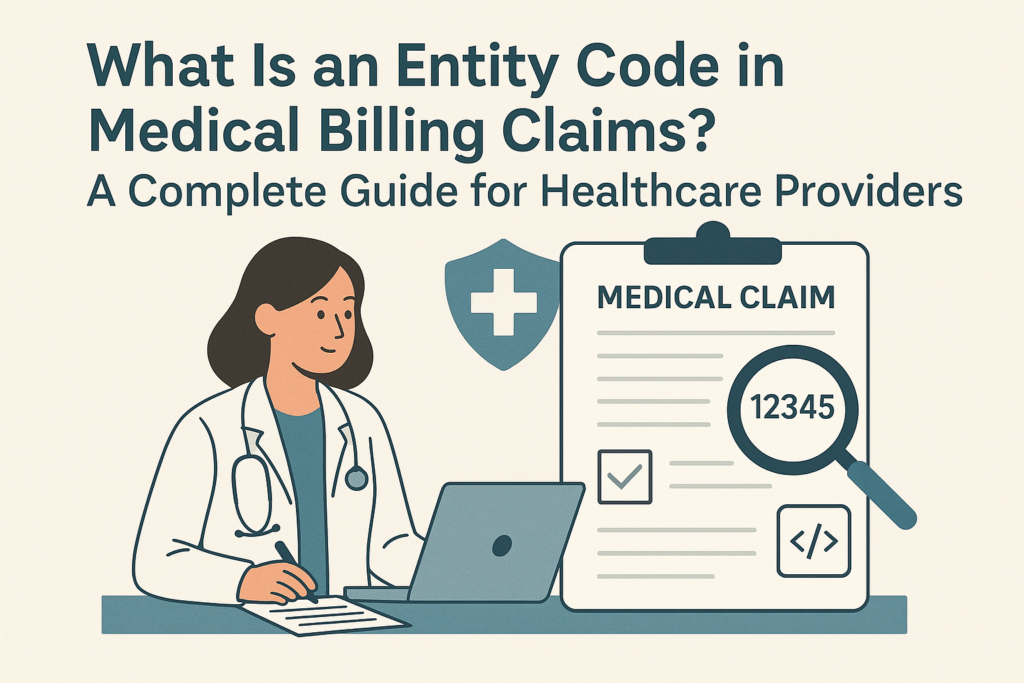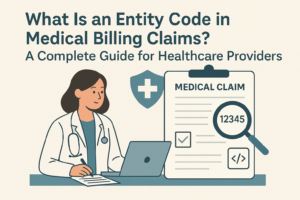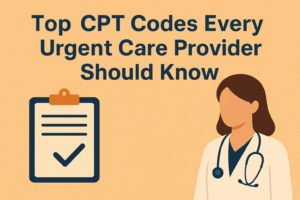Entity code is a small piece of code that is used to explain the service billed in a claim. It helps to ensure that the accurate entity is being billed. Claims denials are common in medical billing. And the major reason behind this denial is using an invalid entry code or missing any entity code. Most people do not give importance to entity codes but in medical billing, these codes are necessary for successful claim submission. As a healthcare provider, you always prefer to have accurate claim submissions and save your practice from denials. So it is important to first understand what exactly an entity code is in medical billing. Why does it matter so much? And most importantly, how do you use it correctly to avoid those pesky denials? Let’s clear all your queries.
What are Entity Codes?
An entity means a single individual and each entity is unique and its services also distinguish it from others. An entity code is a two-character identifier used in electronic healthcare transactions to identify the entity, especially in claim submissions. It tells the payer who’s involved in the transaction—basically, it’s your way of pointing out who the claim or piece of data is referring to. It’s just like a label to tell about the specific entity. In medical billing, there are different types of entity codes for different roles, including:
- Billing provider
- Rendering provider
- Referring provider
- Subscriber (a.k.a. the person who owns the insurance)
- Patient (when different from the subscriber)
Without these specific codes, payers don’t know who’s who. That’s why providers in return face rejections and payment delays, which directly impact the revenue cycle of their practices.
Why Entity Codes Matter in Medical Billing
Medical billing is a complex field because a small mistake or a single number can deny your claim. That’s why entity codes have their own importance in billing. Remember that entity codes are not optional, as these codes help to:
- Identify roles. Is this person the one performing the service or just referring to the patient? Is this the one getting paid or the one covered by insurance? The entity code makes it clear.
- Prevent rejections. If your claim is missing or mislabeling an entity then the payer can directly reject it. That means delayed payment, more back-and-forth, and wasted time.
- Required for compliance. HIPAA standards and ANSI X12 formats require that these codes must be included in certain transactions. So they’re also necessary for compliance.
Common Entity Codes
There are different entity codes but some of the most frequently used entity codes in billing claims include:
- Billing Provider: Entity code 85 for the person or organization getting paid
- Rendering Provider: Entity code 82 for the provider who actually performed the service
- Referring Provider: Entity DN for the one who referred the patient
- Subscriber: Entity code IL for the insured person under the policy
- Patient: Entity code QC for the individual receiving care (can differ from subscriber)
- Service Location: Entity code 77, where the service was rendered (facility, office, etc.)
- Attending Provider: Entity code 72 is typically used in institutional claims (like hospitals)
You’ll find these codes within different loops of an ANSI 837 claim file if you’re submitting electronically.
Where Entity Codes Appear in the 837 Claim Form
If you’re working with electronic claim submissions, you’ll usually see entity codes in an ANSI 837 format, which is a standardized digital way to send claim info to payers.
Entity codes pop up in different loops of this file. These loops are just like sections of the claim form, each with a specific purpose.
Here are a few examples:
- Loop 2010AA: Billing provider (85)
- Loop 2310B: Rendering provider (82)
- Loop 2310A: Referring provider (DN)
- Loop 2010BA: Subscriber (IL)
- Loop 2010CA: Patient (QC)
What are Entity Code Requirements: What You Gotta Include (and Why)
Medical billing companies need to enter the accurate entity code. It helps payers identify someone involved in the care or coverage of the patient. Entity codes require accuracy with complete information and a correct ID number (like an NPI or Tax ID). Payers do not think; instead, they’ll send that claim back faster and cause your revenue cycle delay. Entity codes are required in different situations, including:
- Submitting an electronic claim then you need the entity code.
- Sending details about who performed the service. That’s a rendering provider and it needs the 82 code.
- Billing under a group or facility name. That’s the billing provider (85) and the payer needs to know it.
- The claim includes a referral provider with the DN code.
- When the patient and subscriber are different then you’ll need both QC for the patient and IL for the subscriber.
Common Reasons for Claim Denials Related to Entity Codes
Denials are common due to entity codes. Some common reasons for these details include:
- Entity Code Missing – You forgot to assign one altogether.
- Entity Code Not Valid – You used a code in the wrong loop or context.
- Entity Not Recognized – The payer doesn’t have that provider on file or the ID doesn’t match.
- Rendering Provider Missing – The claim needs to show who performed the service.
- Billing Provider Not Identified – There’s no valid entity code 85 with the billing NPI.
If you’re seeing these, it’s time to go back to the claim and double-check that every provider and patient is tagged with the proper role and code.
Tips to Avoid Entity Code Errors
Entity code issues are common but not impossible to solve. Some ways include:
Use Claim Scrubbing Tools
Many practice management and billing software systems have scrubbing features that can find missing or incorrect entity codes before the claim even gets sent. So try to use them.
Keep Provider Info Updated
Make sure NPIs, tax IDs, and credentials for all providers are correctly stored in your system and are up to date. One wrong digit here can trigger an “entity not recognized” error.
Train Your Staff
Whether it’s front desk staff entering patient/subscriber info or billers finalizing claims, everyone should know the importance of accurate role assignment. Train them to know all these facts.
Check Payer Rules
Not every payer plays by the same rules. Some might need both a billing and rendering provider, even if they’re the same person. Others might have quirks for specialists, facilities, or telehealth.
Audit Denials Regularly
If you’re getting a lot of entity code-related rejections then it’s time to get your denial reports and figure out where the mistake is happening.
Entity Code Best Practices: What Healthcare Providers Should Know
- Don’t assume anything. Even if your system pre-fills certain fields, it’s important to double-check and ensure that the right entity codes are being used for each provider-patient combo.
- Use the correct NPI. The entity code has to align with the correct National Provider Identifier. Billing provider means billing NPI. Rendering provider means rendering NPI. Don’t mix them.
- Don’t forget the referring provider. If a referral was required for the service then make sure you include the DN entity code and the provider’s info.
Institutional claims have extra rules. Hospitals and large facilities often need additional roles like 72 (attending) and 77 (service location). So don’t skip those.







